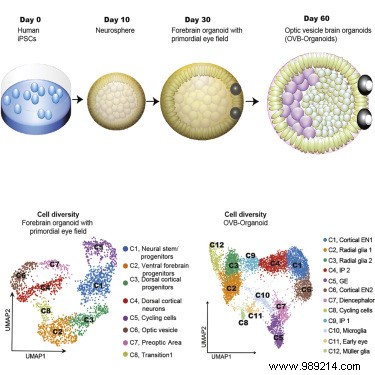Relying on induced pluripotent stem cells, researchers grew brain organoids in the lab that developed eye structures capable of detecting light and detecting light. send signals to the rest of the brain. Details of the study are published in the journal Cell Stem Cell.
The human brain is one of the most complex structures in nature and we are far from having explored it. To help us understand it better, researchers are developing miniature versions of these organs in the laboratory . In a simplified version, here's how it works:skin cells are taken from donors. They are then converted back into so-called "pluripotent" stem cells. The latter are able to differentiate into any type of cell in the body without restriction. The cells are finally placed in a culture that mimics the environment of a developing brain, encouraging them to form different brain cells.
If all goes as planned, then you get a three-dimensional brain model no bigger than a pea . Researchers can then use it to study its development or its responses to diseases or the effects of drugs.
More recently, a team from the University Hospital of Düsseldorf, Germany, went even further by proposing brain organoids that develop optical sections, structures of vision found in the eye where the optic nerve meets the retina.
To do this, the researchers relied on stem cells from four donors. The latter made it possible to grow 314 brain organoids in sixteen batches . Of this sample, approximately 72% have developed optical cups. All began to appear after about thirty days and matured in fifty days. According to the team, human embryos develop retinas in a similar time frame.

Symmetrically developed on the front of the mini brain , these optical cups were functional. Inside these "eyes", several types of retinal cells have indeed formed neural networks capable of responding to light and sending these signals to the brain. The lens and corneal tissue have also formed. Until now, such a result had never been obtained in vitro .
“Our work highlights the remarkable ability of brain organoids to generate primitive light-sensitive sensory structures, harboring cell types similar to those found in the body “, says Jay Gopalakrishnan, lead author of the study.
Ultimately, these organoids could help researchers study brain-eye interactions during the development of the human embryo, to model congenital retinal disorders or to propose new drug approaches.